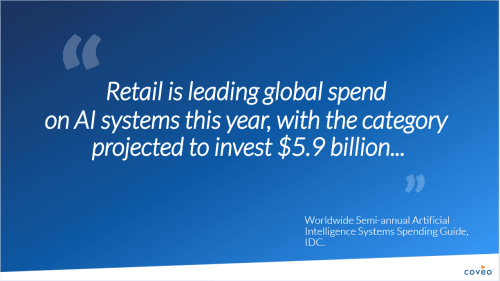How many times a day do you think you interact with AI?
The answer: more than you think. Each time you encounter a personalized experience with an app or search engine that remembers your past searches or purchases, there is a chance machine learning has been part of that journey. And each time, you are frustrated with irrelevant content or recommendations, you’re spotting an opportunity for AI to enhance your experience.
Coveo hosted a webinar,AI and Why We Buy, to uncover myths about AI and further delve into how machine learning can help businesses learn more about the users visiting their sites and in turn, deliver better experiences. Simon Langevin, Senior Product Manager of Coveo for Commerce, delivered the session.
Myth 1: AI is only for the future, not for our current use cases.
There is a common misconception that AI is still a fancy, complicated mechanism that is only for extremely large scale technical initiatives. Nothing could be farther from the truth.

AI is critical to keep up with buying behavior: 91% of shoppers prefer that brands customize and personalize recommendations based on past purchases (Bond Internet Trends, 2019). According to data from Amazon, 35% of their purchases come from personalized recommendations… and that was in 2013, the last time they shared this type of data publicly. This is huge. Big brands are already using AI to personalize and recommend products or content to their users.
Myth 2: Investing in AI means buying a toolbox to build models.
Thinking that one needs to buy an isolated toolbox is the wrong way to think about AI and how to incorporate it into one’s business. Commerce businesses need to invest in everything that will allow you to create outputs with AI. But AI is not a magic wand a company can wave over its business to guarantee better search. There are three important factors necessary to create an ecosystem where increased relevance is possible. They are:
- Content: A connected data and knowledge ecosystem. Many brands encounter a problem when it comes to access to content. Manually tagging content types limits the ability of discovery and recommendation for users, so an automated solution is necessary.
- Context: A clear user profile that integrate use-case behavior is essential. The good news is that many e-commerce businesses are already well on the right path to the “Context” portion of this journey, as they have reams of data related to their customers. Loyalty cards are a big win here. If you’re a retailer and have no data on your customers purchasing history, it’s important to start now.
- Intent: Behavior analytics that analyze the success and shortcomings of a business’s interactions with their customers is critical. It’s also important to segment each user interaction separately so that the search function is not offering customers irrelevant information: If a user previously searched Amazon for televisions but is now looking for dog food, the previous search results will mean nothing in the second search and will likely lead to an abandoned search.

It is essential for a business to invest in these fundamental elements first before one can start thinking about machine learning models.
Myth 3: AI is only useful in complex scenarios.
Personalized recommendations are now the minimum expectation – and companies need to apply AI to every interaction with their customers now. Even when ordering your daily McDonald’s order through the app, you most likely come to expect it’s remembered what you ordered in the past. Here is where can we use AI in standard e-commerce practices.
- Facilitate Content Discovery. Auto-filling suggested terms has been shown to instantly increase conversion rates.
- Reduce the Steps to Conversion. E-commerce users will use category navigation often. When they reach the landing page, even if there is no search bar, most of them will start using filters, facets or other navigation tools to help them move around. Reordering that navigation path is possible and can help reduce steps between the moment a user lands on-site to when they make a purchase.
- Increase Revenue Per Visit. When a user hits the cart, it’s important to be able to show additional relevant recommendations to facilitate a cross-sell of related items.
Instead of showing terms associated with a search that might be irrelevant, dynamic navigation will offer the most relevant filters associated with your search.

The results of applying to AI in ecommerce experiences speak for themselves. One example: A nutrient based supplements retailer based in the UK has seen a 16 percent increase in conversion rate after investing in machine learning solutions with Coveo. They saw that increase just from offering additional query suggestions. Enabling users to easily discover relevant content, in a lexicon that they are using to search, has huge positive benefits for businesses and AI will be an integral part of creating that customer journey, at scale.


